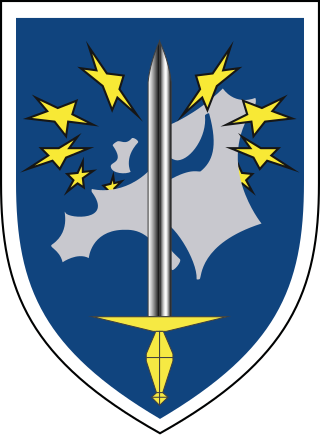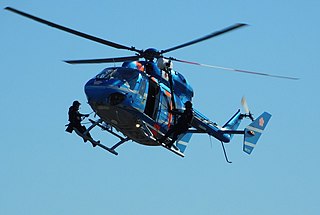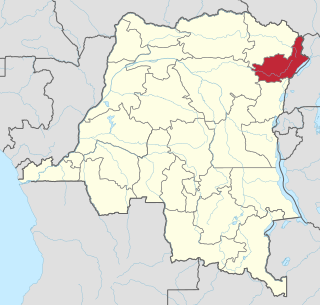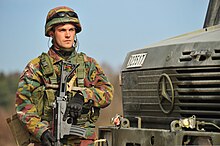
The Finnish Defence Forces (FDF) (Finnish: Puolustusvoimat, Swedish: Försvarsmakten) are the military of Finland. The Finnish Defence Forces consist of the Finnish Army, the Finnish Navy, and the Finnish Air Force. In wartime, the Finnish Border Guard becomes part of the Finnish Defence Forces.

The North Atlantic Treaty Organization, also called the North Atlantic Alliance, is an intergovernmental military alliance of 32 member states—30 European and 2 North American. Established in the aftermath of World War II, the organization implements the North Atlantic Treaty, signed in Washington, D.C., on 4 April 1949. NATO is a collective security system: its independent member states agree to defend each other against attacks by third parties. During the Cold War, NATO operated as a check on the threat posed by the Soviet Union. The alliance remained in place after the dissolution of the Soviet Union and the Warsaw Pact, and has been involved in military operations in the Balkans, the Middle East, South Asia and Africa. The organization's motto is animus in consulendo liber. The organization's strategic concepts include deterrence.

The Swedish Armed Forces are the armed forces of the Kingdom of Sweden, tasked with the defence of the country as well as with promoting Sweden's wider interests, supporting international peacekeeping, and providing humanitarian aid. It consists of four service branches: the Swedish Army, the Swedish Air Force and the Swedish Navy, as well as a military reserve force, the Home Guard. Since 1994, all Swedish military branches are organised within a single unified government agency, the Swedish Armed Forces Headquarters, which is headed by the Supreme Commander, even though the individual services maintain their distinct identities.

Eurocorps, located in the French city of Strasbourg (Bas-Rhin), is a multinational corps headquarters. Founded by France and Germany in 1992, it is today composed of personnel from six framework nations and five associated nations. The framework nations place the Eurocorps at the service of the European Union (EU) and NATO, which certified it in 2002 as one of its nine High Readiness Land Headquarters.

A rapid reaction force / rapid response force (RRF), quick reaction force / quick response force (QRF), immediate reaction force (IRF), rapid deployment force (RDF), or quick maneuver force (QMF) is a military or police unit capable of responding to emergencies in a very short time frame.

The European Gendarmerie Force (EUROGENDFOR) is a European rapid reaction force composed of elements of several European police and gendarmerie forces. EUROGENDFOR is tasked with performing policing tasks within the scope of crisis management operations.

The Common Security and Defence Policy (CSDP) is the European Union's (EU) course of action in the fields of defence and crisis management, and a main component of the EU's Common Foreign and Security Policy (CFSP).

Operation Artemis, formally European Union Force Democratic Republic of the Congo (EUFOR), was a short-term European Union-led UN-authorised military mission to the Democratic Republic of the Congo during the Ituri conflict. ARTEMIS is considered the first military operation led by the EU, the first autonomous EU operation, the first rapid response mission of the EU, first operation outside Europe, first operation applying the principle of the framework nation and first example of "relay operation", conducted in cooperation between the EU and the United Nations. The deployment of EUFOR troops quickly decreased the conflict's intensity. It marked the first autonomous EU military mission outside Europe and an important milestone in development of the European Security and Defence Policy.

The European Rapid Operational Force (EUROFOR) was a multinational rapid reaction force composed of forces from four states of the European Union: Italy, France, Portugal and Spain. It had a permanent staff capable of commanding operations, involving commitments of up to a Light Division in size. Eurofor was formed in May 1995 in Lisbon, and was answerable to the Western European Union (WEU) directly. It was tasked with performing Petersberg tasks, including humanitarian, peacekeeping and peace enforcement missions. With the merger of several WEU elements into the European Union, Eurofor had by and large become part of the Common Security and Defence Policy. It was eventually transformed into an EU Battlegroup and was on standby from 1 July until 31 December 2011. On 2 July 2012, Eurofor was dissolved.

The Nordic Battlegroup (NBG) is one of eighteen European Union battlegroups. It consists of around 2,500 soldiers including officers, with manpower contributed from the seven participating Northern European countries, Sweden, Finland, Norway, Ireland, Estonia, Latvia, and Lithuania. The military strategic command of the force is done in cooperation with any of the suitable five Operation Headquarters framework nations at the time for deployment. Before 2022, Denmark opted out of the Common Security and Defence Policy of the EU, hence all battlegroups. Norway has negotiated an opt-in to participate, even though it is not an EU member state. Sweden, Finland and Norway have planned to form a joint battlegroup.

European Union Force Chad and the Central African Republic, also EUFOR Tchad/RCA after the French, was the European Union mission in Chad and the Central African Republic (CAR), authorised in late 2007. EUFOR Chad/CAR was authorised under the same United Nations Security Council resolution that mandated MINURCAT, a UN force tasked with training police and improving judicial infrastructure.
The British Battlegroup or UK Battlegroup is an EU Battlegroup, consisting entirely of British armed forces. It was on standby from 1 January, until 30 June 2005, and from 1 July, until 31 December 2008.
The Visegrád Battlegroup or V4 EU Battlegroup is an EU Battlegroup led by Poland, in which the other fellow Visegrád Group countries – the Czech Republic, Slovakia and Hungary participate. It was on standby from 1 January until 30 June 2016 and from 1 July until 31 December 2019. It is scheduled to go on standby in the first half of 2023.

The Weimar Battlegroup is a multinational EU Battlegroup under Polish leadership, in which Germany and France also participate as members of the Weimar Triangle. It was on standby in the first half of 2013.

Enhanced Forward Presence (EFP) is a NATO-allied forward-deployed defense and deterrence military force in Northern, Central and Eastern Europe. This posture in Northern Europe through Estonia, Latvia, and Lithuania and in Central Europe through Poland, Slovakia and Hungary and in Eastern Europe through Romania and Bulgaria, is in place to protect and reassure the security of NATO's Northern, Central and Eastern European member states on NATO's eastern flank.

Robert Peter Bauer is a lieutenant-admiral in the Royal Netherlands Navy, currently serving as the Chair of the NATO Military Committee since June 2021, after succeeding Air Chief Marshal Sir Stuart Peach. Bauer previously served as the Chief of Defence from October 2017 to April 2021, and as the Vice Chief of Defence of the Armed forces of the Netherlands from 1 September 2015 to 13 July 2017. Bauer was also involved in anti-terrorist and anti-piracy operations in the Mediterranean Sea, and in the Horn of Africa.

This article outlines the history of the Common Security and Defence Policy (CSDP) of the European Union (EU), a part of the Common Foreign and Security Policy (CFSP).

This article outlines the defence forces of the European Union (EU), which implement the EU's Common Security and Defence Policy (CSDP) in CSDP missions. There are two categories of EU multinational forces: ones that have been established intergovernmentally and made available to the CSDP through article 42.3 of the Treaty on European Union (TEU), such as the Eurocorps; and the EU Battlegroups, established at the EU level.
The Strategic Compass for Security and Defence is a roadmap document written by the European External Action Service in 2022. and adopted on 25 May 2022 by the European Council. Josep Borrell, the foreign policy chief at the time, said that it was a "turning point for the European Union as a security provider and an important step for the European security and defence policy." He also said that given the 2022 Russian invasion of Ukraine, a "sea change in EU security and defence" was necessary. The document is seen as a parallel to the National Security Strategy of the United States. It was the first time a collective threat assessment procedure was written. A lengthy list of deliverables included the birth of the Rapid Deployment Capacity, by 2025. Its intended reach was global. A lecturer thought that "Russia has unleashed the strongest push to strengthen Europe’s defence since the end of the Cold War", and that this document provided the necessary impetus.



















